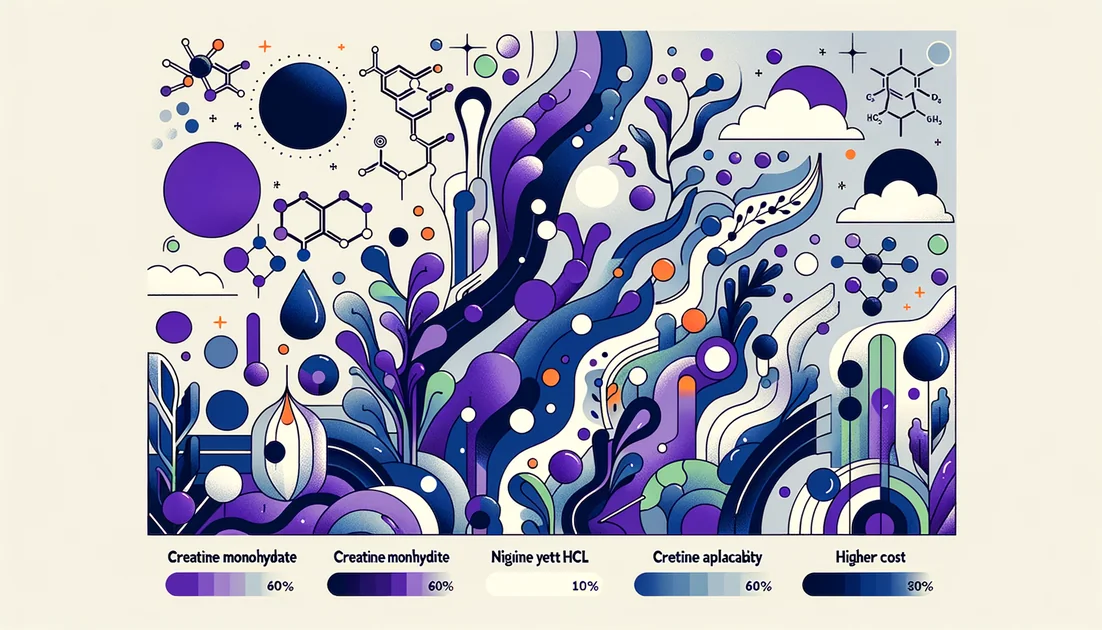
Top 8 Evidence-Based Recommendations
Quick Reference Card
Omega-3 EPA/DHA (2–4 g/day) — lowers TG and testosterone, raises SHBG [5]
CoQ10 (100–200 mg/day) — improves HOMA-IR and lipids [4]
Berberine (500 mg 2–3×/day) — metabolic + fertility adjuvant [10]
Show all 8 supplements...
Probiotics/Synbiotics (10^9–10^10 CFU) — modest HOMA-IR drop [12]
Spearmint tea (2 cups/day) — anti-androgen assist [13]
Ranked Recommendations
#1Myo-inositol + D-chiro-inositol (40:1)Top Choice
The cycle-reset combo most likely to restore ovulation
Dose: 2 g myo-inositol + 50 mg DCI twice daily (40:1 ratio), for 8–12+ weeks
Time to Effect: 4–8 weeks for cycle regularity; 3 months for ovulation/quality
How It Works
Evidence
Irregular cycles, anovulation, insulin resistance, trying to conceive
GI upset in some; avoid high-dose DCI-only products. [3]
Split doses (AM/PM) and take before meals for steadier insulin signaling. [2]
#2Omega-3 (EPA/DHA)Strong Alternative
The lipid-and-androgen tamer
Dose: 2–4 g/day combined EPA+DHA with meals
Time to Effect: 8–12 weeks
How It Works
Omega-3s lower hepatic VLDL output and systemic inflammation, nudging down insulin resistance, LH, and total testosterone while boosting SHBG. [5]
Evidence
High triglycerides, low SHBG, inflammatory phenotype
Bleeding risk at higher doses with anticoagulants; fishy aftertaste.
Aim for ≥1.5 g/day EPA to drive endocrine effects; choose IFOS-tested concentrates.
#3Coenzyme Q10 (ubiquinol)Worth Considering
Mitochondrial support that moves HOMA-IR
Dose: 100–200 mg/day (prefer ubiquinol) with fat
Time to Effect: 8–12 weeks
How It Works
CoQ10 improves mitochondrial electron transport and reduces oxidative stress, which improves insulin signaling and modestly lowers androgens/lipids. [4]
Evidence
Systematic review/meta-analysis of 9 RCTs (n≈1,021) found improvements in HOMA-IR, fasting insulin/glucose, testosterone, and lipids in PCOS. [4]
Fatigue + insulin resistance; statin-users with PCOS
May lower BP; separate from thyroid meds by several hours.
Pair with omega-3 for additive cardiometabolic gains.
#4N-acetylcysteine (NAC)
Ovulation helper with antioxidant punch
Dose: 600 mg 2–3×/day (1.2–1.8 g/day), 6–12 weeks
Time to Effect: 6–12 weeks
How It Works
Evidence
Ovulation induction (esp. with CC/letrozole), oxidative-stress phenotype
GI upset; interacts with nitroglycerin.
If clomiphene-resistant, combine NAC with your induction protocol for a pragmatic boost. [8]
#5Berberine
Metformin-like metabolic effects—herbal edition
Dose: 500 mg with meals 2–3×/day (1–1.5 g/day), 8–12+ weeks
Time to Effect: 8–12 weeks
How It Works
Activates AMPK, reducing hepatic gluconeogenesis and improving lipid handling; may enhance endometrial thickness. [10]
Evidence
Insulin resistance + infertility where metformin is not tolerated
Drug interactions (CYPs/P-gp); avoid in pregnancy/breastfeeding.
Pulse 8–12 weeks then reassess; combine with omega-3 for lipid control.
#6Vitamin D (if low)
Deficiency fix that modestly lowers T and CRP
Dose: 1,000–4,000 IU/day (target 25-OH D 30–50 ng/mL)
Time to Effect: 8–12 weeks for labs
How It Works
Evidence
Documented deficiency; high androgens/inflammation
Fat-soluble—avoid >4,000 IU/day long-term without labs.
Co-supplement with magnesium if levels are low to improve response.
#7Probiotics/Synbiotics
Small but real help for insulin and androgens
Dose: ≥10^9–10^10 CFU/day for 8–12 weeks; synbiotics often outperform probiotics
Time to Effect: 8–12 weeks
How It Works
Gut–liver–ovary axis: improved barrier and endotoxemia lowers insulin resistance and free androgens (↑SHBG). [12]
Evidence
Bloating + metabolic PCOS; as an add-on to inositol/omega-3
Strain-specific effects; avoid proprietary blends without CFU/strain labels.
Look for L. acidophilus/B. lactis blends with prebiotic fiber (inulin/FOS). [12]
#8Spearmint tea
Simple anti-androgen sip for hirsutism
Dose: 1 cup (250 mL) 2×/day
Time to Effect: 30 days for androgen changes; cosmetic changes take longer
How It Works
Decreases free testosterone and may increase LH/FSH balance; clinical effect on hair takes months. [13]
Evidence
30-day RCT showed significant anti-androgen effects vs placebo tea; hirsutism score changes were small over 1 month. [13]
Mild hirsutism or as adjunct while other therapies kick in
None common; consider dental enamel with frequent herbal teas.
Pair with inositol + omega-3 for systemic control of androgens.
Common Questions
How long until supplements help PCOS?
Most metabolic/androgen changes show by 8–12 weeks. Ovulation/cycle regularity often needs 3 months, sometimes 6.
Can I take inositol with metformin?
Yes. Trials show MI+DCI can add to metformin for cycle regularity; start low to avoid GI upset. [2]
Best supplement for PCOS and fertility?
Inositol 40:1 is first-line; consider adding NAC if inducing ovulation and omega-3 for lipids/androgens. [1][2][8]
Do I need vitamin D if my level is normal?
Probably not. Benefits are strongest when correcting deficiency—don't mega-dose without labs. [6][7]
Is berberine safe long-term?
Use in 8–12-week blocks and review with your clinician; it interacts with meds and isn't advised in pregnancy. [10]
Timeline Expectations
Fast Results
Combination Strategies
Ovulation & Cycle Reset Stack
Components:Myo-inositol + D-chiro-inositol (40:1) + N-acetylcysteine + Vitamin D (if low)
Addresses insulin signaling (inositols), oxidative stress/endometrium (NAC), and corrects common deficiency linked to androgen excess. Shown to improve ovulation, endometrial thickness, and androgens. [1][8][6]
Daily: MI 2 g + DCI 50 mg twice daily; NAC 600 mg 2–3×/day; Vitamin D 1–4k IU with fat. Reassess cycles at 12 weeks.
Metabolic & Androgen Downshift
Components:Omega-3 EPA/DHA + CoQ10 + Berberine
Synergistic lipid lowering (omega-3), mitochondrial insulin signaling (CoQ10), and AMPK activation (berberine) yield additive reductions in HOMA-IR, TG, and testosterone. [5][4][10]
With meals: Omega-3 to 2–4 g EPA+DHA/day; CoQ10 100–200 mg/day; Berberine 500 mg 2–3×/day. 8–12 weeks, then lab check.
Gut–Hormone Support (Adjunct)
Components:Synbiotic (probiotic + prebiotic) + Spearmint tea
Microbiome modulation modestly improves insulin and SHBG while spearmint provides a quick anti-androgen nudge. [12][13]
Daily synbiotic providing ≥10^10 CFU plus inulin/FOS; spearmint tea 1 cup twice daily for ≥8 weeks.
You might also like
Explore more of our evidence-led investigations, comparisons, and guides across every article style.

Nutricost
Nutricost's Value Paradox: Strong Prices on Basics, Uneven Transparency on Testing

Creatine Monohydrate (CM) vs Creatine Hydrochloride (Cr-HCl)
For most people, choose Creatine Monohydrate for proven results, simple dosing, and best value. Consider Creatine HCL only if you consistently get GI upset from CM and are willing to pay more; it hasn't shown better outcomes in trials. [1][2][4][5]


L-Isoleucine
You swirl a post-workout shake, thinking about muscle recovery, when a quieter story unfolds inside your body: a single amino acid that can nudge blood sugar down within an hour—and yet, when it lingers too high in the bloodstream for too long, it's tied to diabetes risk. Welcome to the paradox of L-isoleucine.


Tocotrienols
The stealthier cousins of vitamin E—built with springy tails that move differently in cell membranes and behave differently in your body.











